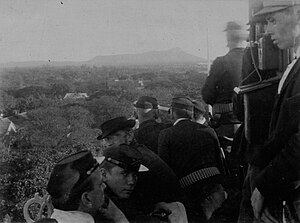1895 Counter-Revolution in Hawaii
| 1895 Counter-revolution in Hawaii | |||||||
|---|---|---|---|---|---|---|---|
| Part of the Hawaiian rebellions (1887–1895) | |||||||
 National Guardsmen atop ʻIolani Palace during the Uprising of 1895. |
|||||||
|
|||||||
| Belligerents | |||||||
|
|
|
||||||
| Commanders and leaders | |||||||
|
Sanford B. Dole Edward G. Hitchcock |
Samuel Nowlein (POW) Robert W. Wilcox (POW) |
||||||
| Strength | |||||||
|
1,200 Police Force |
400–500 insurgents | ||||||
| Casualties and losses | |||||||
| 1 killed | Several killed 190–220 captured Most deserted |
||||||
Decisive Republican Victory
1,200
500 Citizens' Guards
5 Companies National Guard of Hawaii
2 Companies, Regular Army
The 1895 Wilcox rebellion was a brief war from January 6 to January 9, 1895, that consisted of three battles on the island of Oʻahu, Hawaiʻi. It was the last major military operation by royalists who opposed the overthrow of the Kingdom of Hawaii.
Because of its brevity and lack of casualties, this conflict is largely forgotten; in some cases those who rediscover it coin a new name for the conflict, but it is frequently referred to as the “Counter-revolution”.
The war has also been called the second Wilcox rebellion of 1895, the revolution of 1895, the Hawaiian counter-revolution of 1895, the 1895 uprising in Hawaii, the Hawaiian civil war, the 1895 uprising against the provisional government, or the uprising of 1895.
Following the 1887 Hawaiian Constitution and the 1893 coup d'état, a temporary government was formed by the Committee of Safety until an assumed annexation by the United States. They were successful with President Benjamin Harrison in negotiating an annexation treaty; however, Harrison's term in office came to an end before the treaty could be ratified by Congress. The new President, Grover Cleveland, opposed the idea of annexation, being an anti-imperialist himself, and withdrew the annexation treaty upon taking office. After commissioning the secret Blount Report, he stated that the U.S. had inappropriately used military force and called for the reinstatement of Queen Liliʻuokalani. The matter was referred by Cleveland to Congress after Sanford Dole refused Cleveland's demands, and the U.S. Senate held a further investigation, culminating in the Morgan Report, which completely rejected that there had been any U.S. involvement in the overthrow.
The Provisional Government feared that President Cleveland might continue to support the queen by restoring the monarchy. The Provisional Government also realized there would be no annexation until Cleveland's term of office ended; and they wanted to establish a more permanent government until another president, more favorable toward annexation, came to office. Therefore, the Provisional Government called to order a Constitutional Convention on May 30, 1894. The Constitutional Convention drafted a constitution for a Republic of Hawaii. The Republic of Hawaii was proclaimed on 4 July 1894 at Aliiolani Hale. The Republic was a single-party oligarchy that deprived the native people of political participation.
...
Wikipedia
